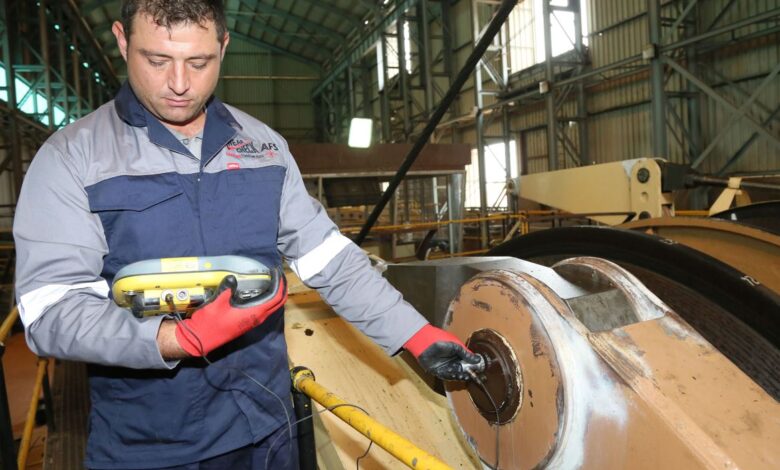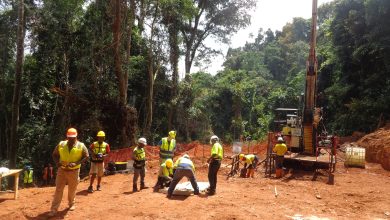
Non-destructive testing (NDT) Solutions for mining equipment
Non-destructive testing boosts mines’ productivity
“WearCheck’s highly experienced, well-trained technicians conduct a multitude of visual inspections on a range of components daily.”
Non-destructive testing (NDT) is one of the advanced field services offered by specialist condition monitoring company, WearCheck.
In addition to traditional oil analysis techniques, the company’s service offering includes other advanced field services (rope testing, technical compliance), asset reliability care (ARC) services, transformer oil analysis, water analysis, and lubricant-enabled reliability (LER) services.
Expert technicians trained within each analysis and monitoring technique perform the tests using highly specialised equipment. Test results are assessed by experienced team members, and feedback is sent to the client.
NDT manager for WearCheck, Adri Ludick, explains NDT. ‘We conduct a variety of testing techniques through which the properties and condition of a component are evaluated without causing any permanent damage to it. This is a useful condition monitoring technique in many sectors, particularly mining, where it helps to enhance asset reliability and availability.
‘Typically, NDT is used in critical mining component assessments, machine condition assessments, and inspection of ancillary equipment such as main vent fans, compressors, mills, pumps and conveyors.
‘In addition to visual inspection, our main tests include eddy-current-, magnetic-particle-, liquid penetrant-, and ultrasonic testing.
‘NDT does not permanently alter the object undergoing inspection, making NDT a convenient asset reliability enhancement tool.
Eddy-current testing
This detects surface defects, (e.g. early-stage cracks), on metallic machine components, and is used across many industries, from aerospace to beer brewing. This NDT technique is applicable to both magnetic and non-magnetic components, including steel, copper, brass and aluminium.
A high-frequency electric current (an eddy current) is induced into the material, and the response is measured, yielding a profile of the component.
Defect-free material has a very specific “fingerprint”, therefore, when the test results are compared to this, the presence of defects is indicated.
With cracks, the earlier they are detected, the less potential damage they cause. Eddy-current testing detects crack initiation at extremely early stages.
An advanced option is the phased-array eddy-current testing, which creates a 3D picture of the component, giving greater visual insight.
Magnetic-particle testing
This is a similar application to eddy-current testing, in that both techniques detect surface cracks on magnetic materials. This technique, which is used across a wide range of industries is only used on magnetic material, such as steel.
The process in this test is to magnetise the component and then saturate it with a very fine magnetised ink or a fine powder.
Any anomaly in the surface being tested causes a concentration of the magnetic field around it, therefore drawing the magnetic ink to the crack and making the defect visually detectable. (Eddy-current testing requires the interpretation of a signal on an oscilloscope screen.)
An advantage of magnetic particle testing is that it can be used to test very large surface areas, very quickly.
Liquid-penetrant testing
This is typically performed on non-magnetic materials (e.g., copper, aluminium), and is essentially a non-magnetic version of magnetic particle testing.
It involves a five-step process. Firstly, the surface is cleaned of all foreign material. Next, it is saturated with a non-harmful penetrating ink. The surface does not have to be horizontal. Thirdly, the penetrant is wiped off the surface of the material. Fourth, a developing chemical is applied over the ink. The developer draws the penetrant from any cracks to form a visible indication. In the fifth step, the component surface is visually examined during and after the development process and results are recorded.
This method is used to test such items as vehicle components and ventilation fan blades.
Ultrasonic testing
A “fish finder” on a fishing boat reveals the depth and size of the fish. Similarly, this methodology allows technicians to see sub-surface defects in both metal and non-metal components.
An ultrasonic flaw-detector instrument fires ultrasonic pulses into the material, and simultaneously detects the reflection. By measuring the time difference between the pulse and the reflection and knowing the speed of sound in the test material, the location of the defect is pinpointed.
An advanced option is phased-array ultrasonic testing, where 64 pulses (instead of one) are fired into the component. By fine-tuning the pulse-strength, we can “steer” the beam in different directions. The advanced option yields a 3D picture of the component, instead of merely a pulse on a screen.
WearCheck’s condition monitoring services are used by clients operating in a large and diverse range of industries, including mining, earth-moving, power generation, aviation, maritime, industrial, manufacturing, construction and others.
Ultrasonic testing
Just how a “fish finder” on a fishing boat reveals the depth and size of the fish, this uses similar methodology, allowing technicians to see sub-surface defects in both metal and non-metal components.
During the process, an ultrasonic flaw detector instrument fires ultrasonic pulses into the material, and simultaneously detects the reflection. By measuring the time difference between the pulse and the reflection and knowing the speed of sound in the test material, you can pinpoint the location of the defect.
It is widely used across all industries to detect anomalies.
An advanced option is phased array ultrasonic testing, where, instead of one pulse, 64 pulses are fired into the component. By fine-tuning the pulse-strength, we can “steer” the beam in different directions. The advanced option enables us to get a 3D picture of the component, instead of merely a pulse on a screen.
Visual inspection
WearCheck’s highly experienced, well-trained technicians conduct a multitude of visual inspections on a range of components daily. Their eyes are conditioned to recognise early-stage defects which are visible, and to identify potential “hotspots” which require further testing.
Founded in Durban, South Africa in 1976, WearCheck serves as a hub for a significant array of condition monitoring techniques, making its services available to clients across the African content and beyond.
To ensure that clients gain maximum benefit from the different monitoring programmes, and to empower maintenance crews to stay ahead of advancing technology, the company offers a selection of technical training courses, many of which earn the delegates sought-after continuing professional development (CPD) points.






